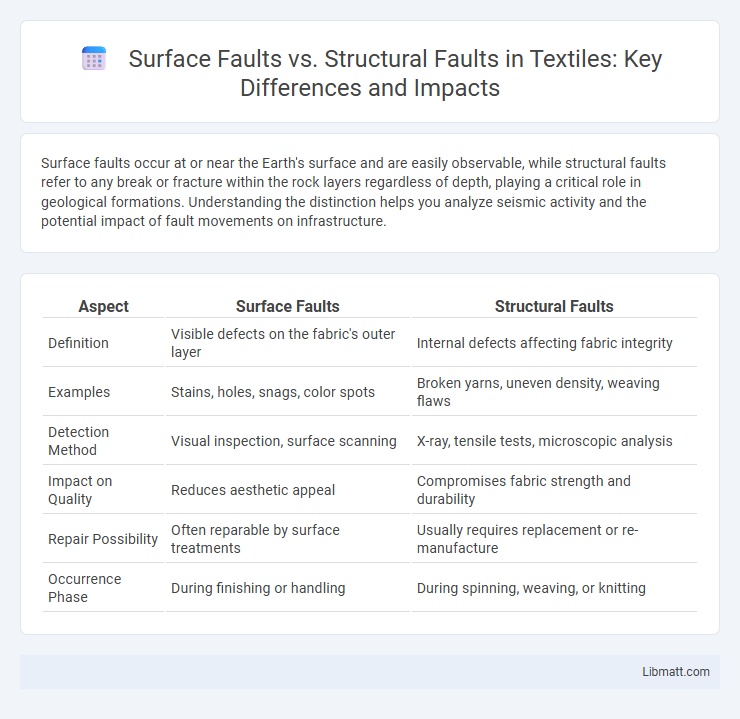Surface faults occur at or near the Earth's surface and are easily observable, while structural faults refer to any break or fracture within the rock layers regardless of depth, playing a critical role in geological formations. Understanding the distinction helps you analyze seismic activity and the potential impact of fault movements on infrastructure.
Table of Comparison
| Aspect | Surface Faults | Structural Faults |
|---|---|---|
| Definition | Visible defects on the fabric's outer layer | Internal defects affecting fabric integrity |
| Examples | Stains, holes, snags, color spots | Broken yarns, uneven density, weaving flaws |
| Detection Method | Visual inspection, surface scanning | X-ray, tensile tests, microscopic analysis |
| Impact on Quality | Reduces aesthetic appeal | Compromises fabric strength and durability |
| Repair Possibility | Often reparable by surface treatments | Usually requires replacement or re-manufacture |
| Occurrence Phase | During finishing or handling | During spinning, weaving, or knitting |
Introduction to Surface and Structural Faults
Surface faults are fractures visible on the Earth's surface where displacement has occurred, often resulting in noticeable changes such as cliffs or fissures. Structural faults lie beneath the surface and influence the geological architecture by altering rock formations and stress distribution without necessarily manifesting at the surface. Understanding both types is crucial for assessing seismic hazards and guiding engineering projects in fault-prone areas.
Defining Surface Faults
Surface faults are fractures in the Earth's crust that visibly break through to the ground surface, often causing noticeable displacement or deformation. These faults directly impact topography and can lead to significant geological hazards, such as earthquakes and landslides. Understanding surface faults is crucial for assessing seismic risk and planning construction projects on or near fault lines.
Understanding Structural Faults
Structural faults are fractures or zones of weakness in the Earth's crust where significant displacement has occurred due to tectonic forces, often leading to mountain building and earthquakes. Unlike surface faults that are visible at the Earth's surface, structural faults may extend deep underground and influence the formation and deformation of rock layers. Understanding structural faults is crucial for assessing seismic risk and guiding the design of infrastructure to ensure your safety in fault-prone areas.
Key Differences Between Surface and Structural Faults
Surface faults are visible fractures or discontinuities on the Earth's surface caused by the movement of tectonic plates, while structural faults refer to any breaks or weaknesses within the Earth's crust that influence geological formations and rock layers. Surface faults often result in obvious topographical changes such as fault lines, scarps, or shifts in land elevation, whereas structural faults may only be detected through subsurface analysis or seismic data. Understanding these key differences helps you accurately assess earthquake risks and geological stability in both mapping and construction projects.
Causes of Surface Faults
Surface faults primarily result from near-surface stress changes caused by tectonic forces, erosion, or subsurface fluid movements that create fractures visible on the earth's surface. These faults often originate from shear stress exceeding the strength of shallow crustal materials, leading to displacement along fault planes. Environmental factors such as weathering and seismic activity can also contribute to the development and propagation of surface faults distinct from deeper structural faults formed by long-term geological processes.
Causes of Structural Faults
Structural faults result from tectonic forces that cause deformation within the Earth's crust, often occurring deep underground due to stress from plate movements, folding, or faulting. These faults form when rock layers experience bending, compression, or tension over geological time scales, leading to fractures or displacement along fault planes. Unlike surface faults that visibly disrupt the landscape, structural faults represent subsurface breakages influenced by long-term geodynamic processes.
Impacts on Building Integrity
Surface faults cause visible ground displacement that can directly damage building foundations, walls, and underground utilities, compromising structural stability. Structural faults, hidden beneath the surface, weaken the geological framework supporting buildings, leading to long-term settlement, cracks, and deformation. Understanding the differences between these faults helps you design foundations and structures that withstand both immediate and gradual impacts on building integrity.
Detection and Diagnostic Methods
Surface faults are primarily detected through visual inspections and simple sensor data like vibration or temperature monitoring, revealing abnormalities on the equipment's exterior. Structural faults require advanced diagnostic methods such as ultrasonic testing, radiography, or acoustic emission analysis to identify internal cracks, deformations, or material degradation. Your maintenance strategy benefits from combining both surface and structural fault detection techniques to ensure comprehensive equipment health monitoring.
Prevention and Mitigation Strategies
Surface faults, visible fractures on the Earth's crust, require direct intervention such as controlled excavation and reinforced barriers to prevent ground displacement affecting infrastructure. Structural faults, occurring within underground formations, demand thorough geological assessments and adaptive engineering designs to mitigate risks like subsidence or pipeline rupture. Your best prevention strategy involves integrating real-time monitoring systems with early warning protocols tailored to the specific fault type and local geological conditions.
Conclusion: Managing Fault Types for Safety
Effective management of surface faults and structural faults is crucial for ensuring safety in geotechnical and civil engineering projects. Surface faults, visible fractures on the Earth's surface, require thorough mapping and monitoring to mitigate hazards associated with ground rupture and displacement. Structural faults, often hidden within subsurface layers, demand detailed geophysical analysis and engineering assessment to prevent failures in foundations, tunnels, and other infrastructure.
Surface faults vs Structural faults Infographic

 libmatt.com
libmatt.com